
The standard circulating coinage of the United Kingdom, British Crown Dependencies and British Overseas Territories is denominated in pennies and pounds sterling, and ranges in value from one penny sterling to two pounds. Since decimalisation, on 15 February 1971, the pound has been divided into 100 (new) pence. Before decimalisation, twelve pence made a shilling, and twenty shillings made a pound.
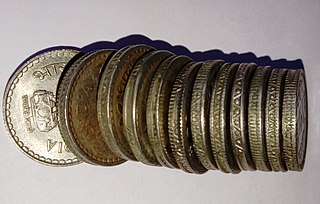
In numismatics, the term milled coinage is used to describe coins which are produced by some form of machine, rather than by manually hammering coin blanks between two dies or casting coins from dies.

The two guinea piece was a gold coin first minted in England in 1664 with a face value of forty shillings. The source of the gold used, also provided the coin its name - the "guinea", with the regular addition of an elephant or castle symbol on the earliest issues to denote bullion supplied by the Royal African Company. For most of its period of production, the coin weighed between 16.7 and 16.8 grams and was 31-32 millimetres in diameter, although the earliest coins of Charles II were about 0.1 grams lighter and 1 millimetre smaller.

The guinea was a coin, minted in Great Britain between 1663 and 1814, that contained approximately one-quarter of an ounce of gold. The name came from the Guinea region in West Africa, from where much of the gold used to make the coins was sourced. It was the first English machine-struck gold coin, originally representing a value of 20 shillings in sterling specie, equal to one pound, but rises in the price of gold relative to silver caused the value of the guinea to increase, at times to as high as thirty shillings. From 1717 to 1816, its value was officially fixed at twenty-one shillings.
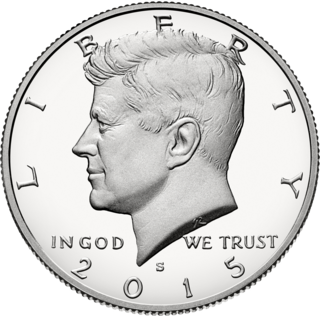
The half dollar, sometimes referred to as the half for short or 50-cent piece, is a United States coin worth 50 cents, or one half of a dollar. In both size and weight, it is the largest United States circulating coin currently produced, being 1.205 inches in diameter and 0.085 in (2.16 mm) in thickness, and is twice the weight of the quarter. The coin's design has undergone a number of changes throughout its history. Since 1964, the half dollar depicts the profile of President John F. Kennedy on the obverse and the seal of the president of the United States on the reverse.

A debasement of coinage is the practice of lowering the intrinsic value of coins, especially when used in connection with commodity money, such as gold or silver coins, while continuing to circulate it at face value. A coin is said to be debased if the quantity of gold, silver, copper or nickel in the coin is reduced.
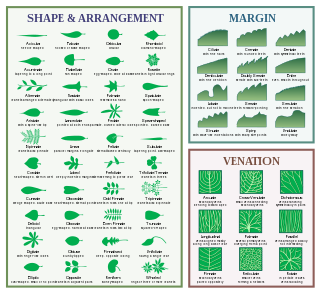
The following terms are used to describe leaf morphology in the description and taxonomy of plants. Leaves may be simple or compound. The edge of the leaf may be regular or irregular, may be smooth or bearing hair, bristles or spines. For more terms describing other aspects of leaves besides their overall morphology see the leaf article.

The rim of a coin is the raised part of the coin that completely encircles the perimeter on both obverse and reverse sides. Not to be confused with the edge of the coin, which is also known as its "third side".
In computer vision and image processing, a feature is a piece of information about the content of an image; typically about whether a certain region of the image has certain properties. Features may be specific structures in the image such as points, edges or objects. Features may also be the result of a general neighborhood operation or feature detection applied to the image. Other examples of features are related to motion in image sequences, or to shapes defined in terms of curves or boundaries between different image regions.

The 2 euro cent coin (€0.02) has a value of one-fiftieth of a euro and is composed of copper-plated steel. All euro coins have a common reverse and country-specific (national) obverse. The coin has been used since 2002 and was not redesigned in 2007 as were the higher-value coins.

The 5 euro cent coin (€0.05) has a value of one twentieth of a euro and is composed of copper-covered steel. All euro coins have a common reverse and country-specific (national) obverse. The coin has been used since 2002 and was not re-designed in 2007 as was the case with the higher-value coins.

The 20 euro cent coin (€0.20) has a value of one-fifth of a euro and is composed of an alloy called Nordic Gold in the Spanish flower shape. All euro coins have a common reverse side and country-specific national sides. The coin has been used since 2002, with the present common side design dating from 2007.

The Tolstoj quadrangle in the equatorial region of Mercury runs from 144 to 216° longitude and -25 to 25° latitude. It was provisionally called "Tir", but renamed after Leo Tolstoy by the International Astronomical Union in 1976. Also called Phaethontias.
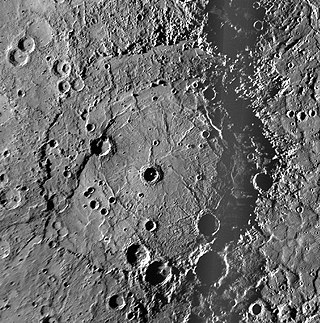
Rembrandt is a large impact crater on Mercury. With a diameter of 716 km it is the second-largest impact basin on the planet, after Caloris, and is one of the larger craters in the Solar System. It was discovered by MESSENGER during its second flyby of Mercury on October 6, 2008. The crater is 3.9 billion years old, and was created during the period of Late Heavy Bombardment. The density and size distribution of impact craters along Rembrandt's rim indicate that it is one of the youngest impact basins on Mercury.
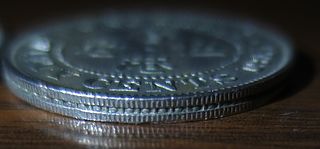
Reeding is a technique wherein a number of narrow ridges called "reeds" are carved or milled into a surface.

The Kamuku National Park is a Nigerian national park in Kaduna State, Nigeria, with a total area of about 1,120 km2 (430 sq mi). The park has a typical Sudanian Savanna ecology.

The landscape polewards of around 30 degrees latitude on Mars has a distinctively different appearance to that nearer the equator, and is said to have undergone terrain softening. Softened terrain lacks the sharp ridge crests seen near the equator, and is instead smoothly rounded. This rounding is thought to be caused by high concentrations of water ice in soils. The term was coined in 1986 by Steve Squyres and Michael Carr from examining imagery from the Viking missions to Mars.

The Lydenburg Heads are seven terracotta heads that were discovered in association with other pottery artifacts in Lydenburg, Mpumalanga, South Africa. They are among the oldest known African Iron Age artworks from South of the equator. Other artefacts found in association with these heads include ceramic vessels, iron and copper beads, and bone fragments. Charcoal associated with the heads was radiocarbon dated, and this relative dating technique places these artifacts and the site at around 1410 BP, which constitutes one of the earliest dates for an Iron Age settlement in South Africa. The heads are hollow with thin clay strips added to create facial details. The skill and thought that went into the designs suggest that they were valued products of a well organised and settled community.

Mother coins, alternatively known as seed coins, matrix coins, or model coins (樣錢), were coins used during the early stages of the casting process to produce Chinese, Japanese, Korean, Ryukyuan, and Vietnamese cash coins. As cash coins were produced using sand casting mother coins were first produced to form the basis for all subsequent cash coins to be released into circulation. Under the Han dynasty in China mints started producing cash coins using bronze master moulds to solve inconsistencies in circulating coins, this only worked partially and by the sixth century mother coins were introduced to solve these inconsistencies almost completely. The Japanese adopted the usage of mother coins in the 600s and they were used to manufacture cast Japanese coins until the Meiji period. The mother coin was initially prepared by engraving a pattern with the legend of the cash coin which had to be manufactured. In the manufacturing process mother coins were used to impress the design in moulds which were made from easily worked metals such as tin and these moulds were then placed in a rectangular frame made from pear wood filled with fine wet sand, possibly mixed with clay, and enhanced with either charcoal or coal dust to allow for the molten metal to smoothly flow through, this frame would act as a layer that separates the two parts of the coin moulds. The mother coin was recovered by the people who cast the coins and was placed on top of the second frame and the aforementioned process was repeated until fifteen layers of moulds had formed based on this single mother coin. After cooling down a "coin tree" (錢樹) or long metallic stick with the freshly minted cash coins attached in the shape of "branches" would be extracted from the mould and these coins could be broken off and if necessary had their square holes chiseled clean, after this the coins were placed on a long metal rod to simultaneously remove the rough edges for hundreds of coins and then these cash coins could be strung together and enter circulation.


















